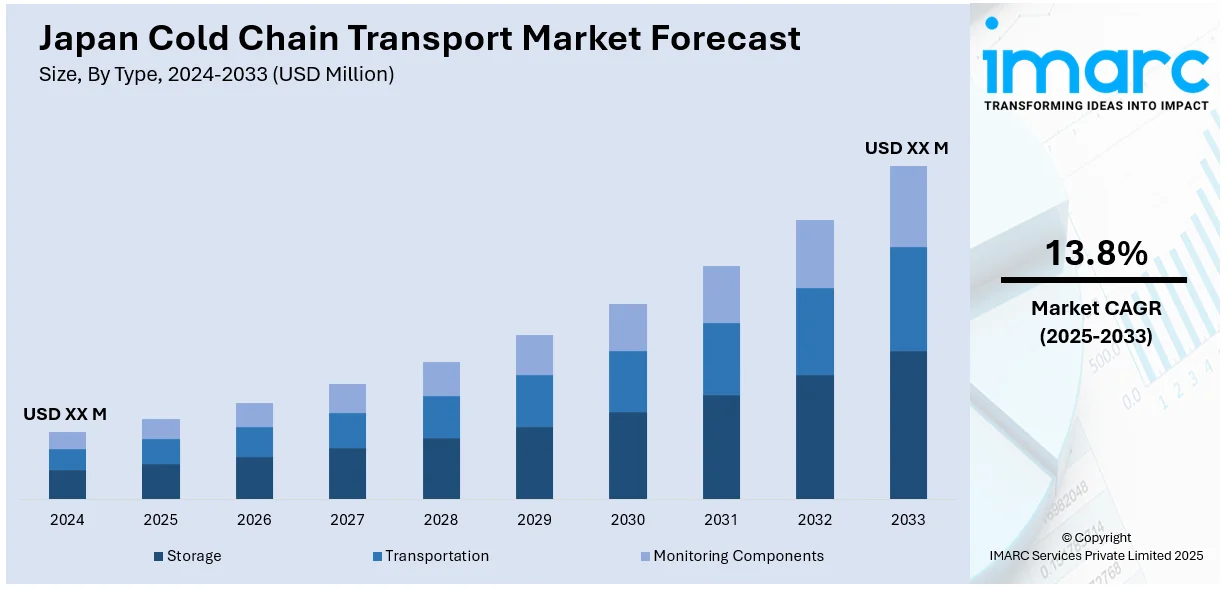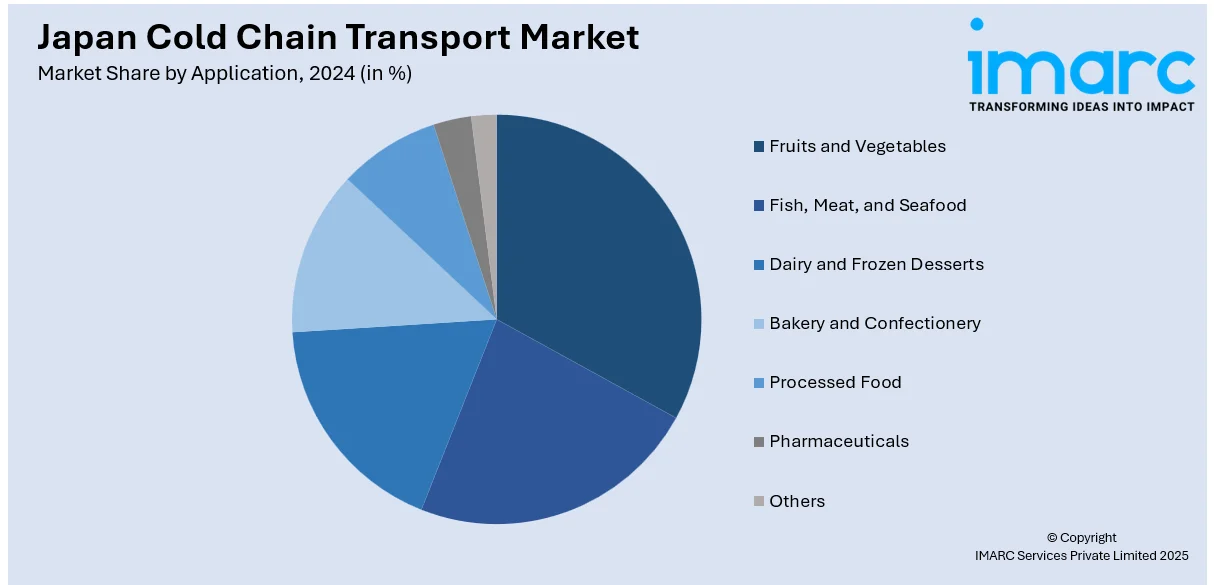
Japan Cold Chain Transport Market Size, Share, Trends and Forecast by Type, Application, Equipment, and Region, 2025-2033
Japan Cold Chain Transport Market Overview:
The Japan cold chain transport market size is projected to exhibit a growth rate (CAGR) of 13.8% during 2025-2033. Growing demand for fresh and frozen food, increasing e-commerce for perishable goods, strict food safety regulations, technological advancements in refrigeration, and the expansion of pharmaceutical and healthcare sectors requiring temperature-sensitive transportation are some of the factors contributing to Japan cold chain transport market share.
|
Report Attribute
|
Key Statistics
|
|---|---|
|
Base Year
|
2024 |
|
Forecast Years
|
2025-2033
|
|
Historical Years
|
2019-2024
|
| Market Growth Rate 2025-2033 | 13.8% |
Japan Cold Chain Transport Market Trends:
Rising Demand for Temperature-Controlled Logistics
The Japan cold chain transport market is experiencing a considerable increase in demand for advanced temperature-controlled logistics. This tendency is driven by several converging variables. To begin, the growing consumption of perishable items such as fresh fruit, seafood, dairy products, and medications demands strict temperature control throughout the supply chain to ensure quality and safety. Second, Japan's developing e-commerce industry has resulted in an increase in online grocery and fresh food delivery services, highlighting the necessity for dependable cold chain transportation to assure timely and temperature-sensitive deliveries to consumers' doorsteps. Furthermore, Japan's aging population and increased frequency of lifestyle-related disorders are driving up consumption of health-conscious and temperature-sensitive food and pharmaceutical items, increasing the need for specialist cold chain solutions. This trend is driving logistics companies to invest in innovative refrigerated trucks, temperature monitoring systems, and efficient warehousing solutions to support the Japan cold chain transport market growth.

Focus on Sustainability and Energy Efficiency
Another notable development in Japan's cold chain transportation business is an increased emphasis on sustainability and energy efficiency. With increasing environmental concerns and stiffer restrictions, logistics organizations are continually looking for solutions to decrease their carbon footprint and operating expenses. This includes the use of energy-saving refrigeration technology in trucks and warehouses, such as natural refrigerants and advanced insulation systems. Furthermore, there is growing interest in alternative fuel vehicles, such as electric and hybrid refrigerated trucks, to reduce greenhouse gas emissions. The use of route optimization software and telematics solutions is also gaining popularity, allowing businesses to enhance fuel economy and shorten travel lengths. Furthermore, collaborative efforts across the supply chain to consolidate shipments and maximize vehicle use are becoming increasingly widespread. This emphasis on sustainability not only coincides with global environmental goals but also improves the operational efficiency and long-term competitiveness of cold chain logistics providers in Japan.
Japan Cold Chain Transport Market Segmentation:
IMARC Group provides an analysis of the key trends in each segment of the market, along with forecasts at the country and regional levels for 2025-2033. Our report has categorized the market based on type, application, and equipment.
Type Insights:
- Storage
- Transportation
- Monitoring Components
The report has provided a detailed breakup and analysis of the market based on the type. This includes storage, transportation, and monitoring components.
Application Insights:

- Fruits and Vegetables
- Fish, Meat, and Seafood
- Dairy and Frozen Desserts
- Bakery and confectionery
- Processed Food
- Pharmaceuticals
- Others
A detailed breakup and analysis of the market based on the application have also been provided in the report. This includes fruits and vegetables, fish, meat, and seafood, dairy and frozen desserts, bakery and confectionery, processed food, pharmaceuticals, and others.
Equipment Insights:
- Storage Equipment
- Transportation Equipment
A detailed breakup and analysis of the market based on the equipment have also been provided in the report. This includes storage equipment and transportation equipment.
Regional Insights:
- Kanto Region
- Kansai/Kinki Region
- Central/Chubu Region
- Kyushu-Okinawa Region
- Tohoku Region
- Chugoku Region
- Hokkaido Region
- Shikoku Region
The report has also provided a comprehensive analysis of all the major regional markets, which include Kanto region, Kansai/Kinki region, Central/Chubu region, Kyushu-Okinawa region, Tohoku region, Chugoku region, Hokkaido region, and Shikoku region.
Competitive Landscape:
The market research report has also provided a comprehensive analysis of the competitive landscape. Competitive analysis such as market structure, key player positioning, top winning strategies, competitive dashboard, and company evaluation quadrant has been covered in the report. Also, detailed profiles of all major companies have been provided.
Japan Cold Chain Transport Market Report Coverage:
| Report Features | Details |
|---|---|
| Base Year of the Analysis | 2024 |
| Historical Period | 2019-2024 |
| Forecast Period | 2025-2033 |
| Scope of the Report |
Exploration of Historical Trends and Market Outlook, Industry Catalysts and Challenges, Segment-Wise Historical and Future Market Assessment:
|
| Types Covered | Storage, Transportation, Monitoring Components |
| Applications Covered | Fruits and Vegetables, Fish, Meat, and Seafood, Dairy and Frozen Desserts, Bakery and confectionery, Processed Food, Pharmaceuticals, Others |
| Equipments Covered | Storage Equipment, Transportation Equipment |
| Regions Covered | Kanto Region, Kansai/Kinki Region, Central/Chubu Region, Kyushu-Okinawa Region, Tohoku Region, Chugoku Region, Hokkaido Region, Shikoku Region |
| Customization Scope | 10% Free Customization |
| Post-Sale Analyst Support | 10-12 Weeks |
| Delivery Format | PDF and Excel through Email (We can also provide the editable version of the report in PPT/Word format on special request) |
Key Questions Answered in This Report:
- How has the Japan cold chain transport market performed so far and how will it perform in the coming years?
- What is the breakup of the Japan cold chain transport market on the basis of type?
- What is the breakup of the Japan cold chain transport market on the basis of application?
- What is the breakup of the Japan cold chain transport market on the basis of equipment?
- What is the breakup of the Japan cold chain transport market on the basis of region?
- What are the various stages in the value chain of the Japan cold chain transport market?
- What are the key driving factors and challenges in the Japan cold chain transport market?
- What is the structure of the Japan cold chain transport market and who are the key players?
- What is the degree of competition in the Japan cold chain transport market?
Key Benefits for Stakeholders:
- IMARC’s industry report offers a comprehensive quantitative analysis of various market segments, historical and current market trends, market forecasts, and dynamics of the Japan cold chain transport market from 2019-2033.
- The research report provides the latest information on the market drivers, challenges, and opportunities in the Japan cold chain transport market.
- Porter's five forces analysis assist stakeholders in assessing the impact of new entrants, competitive rivalry, supplier power, buyer power, and the threat of substitution. It helps stakeholders to analyze the level of competition within the Japan cold chain transport industry and its attractiveness.
- Competitive landscape allows stakeholders to understand their competitive environment and provides an insight into the current positions of key players in the market.
Need more help?
- Speak to our experienced analysts for insights on the current market scenarios.
- Include additional segments and countries to customize the report as per your requirement.
- Gain an unparalleled competitive advantage in your domain by understanding how to utilize the report and positively impacting your operations and revenue.
- For further assistance, please connect with our analysts.
 Request Customization
Request Customization
 Speak to an Analyst
Speak to an Analyst
 Request Brochure
Request Brochure
 Inquire Before Buying
Inquire Before Buying




.webp)




.webp)












